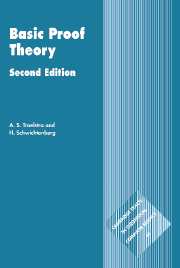Book contents
- Frontmatter
- Contents
- Preface
- 1 Introduction
- 2 N-systems and H-systems
- 3 Gentzen systems
- 4 Cut elimination with applications
- 5 Bounds and permutations
- 6 Normalization for natural deduction
- 7 Resolution
- 8 Categorical logic
- 9 Modal and linear logic
- 10 Proof theory of arithmetic
- 11 Second-order logic
- Solutions to selected exercises
- Bibliography
- Symbols and notations
- Index
2 - N-systems and H-systems
Published online by Cambridge University Press: 05 June 2012
- Frontmatter
- Contents
- Preface
- 1 Introduction
- 2 N-systems and H-systems
- 3 Gentzen systems
- 4 Cut elimination with applications
- 5 Bounds and permutations
- 6 Normalization for natural deduction
- 7 Resolution
- 8 Categorical logic
- 9 Modal and linear logic
- 10 Proof theory of arithmetic
- 11 Second-order logic
- Solutions to selected exercises
- Bibliography
- Symbols and notations
- Index
Summary
Until we come to chapter 9, we shall concentrate on our three standard logics: classical logic C, intuitionistic logic I and minimal logic M. The informal interpretation (semantics) for C needs no explanation here. The logic I was originally motivated by L. E. J. Brouwer's philosophy of mathematics (more information in Troelstra and van Dalen [1988, chapter 1]); the informal interpretation of the intuitionistic logical operators, in terms of the primitive notions of “construction” and “constructive proof”, is known as the “Brouwer–Heyting–Kolmogorov interpretation” (see 1.3.1, 2.5.1). Minimal logic M is a minor variant of I, obtained by rejection of the principle “from a falsehood follows whatever you like” (Latin: “ex falso sequitur quodlibet”, hence the principle is often elliptically referred to as “ex falso”), so that, in M, the logical symbol for falsehood ⊥ behaves like some unprovable propositional constant, not playing a role in the axioms or rules.
This chapter opens with a precise description of N-systems for the full first-order language with proofs in the form of deduction trees, assumptions appearing at top nodes. After that we present in detailthe corresponding term system for the intuitionistic N-system, an extension of simple type theory. Once a precise formalism has been specified, we are ready for a section on the Godel-Gentzen embedding of classical logic into minimal logic. This section gives some insight into the relations between C on the one hand and M, I on the other hand.
- Type
- Chapter
- Information
- Basic Proof Theory , pp. 35 - 59Publisher: Cambridge University PressPrint publication year: 2000



